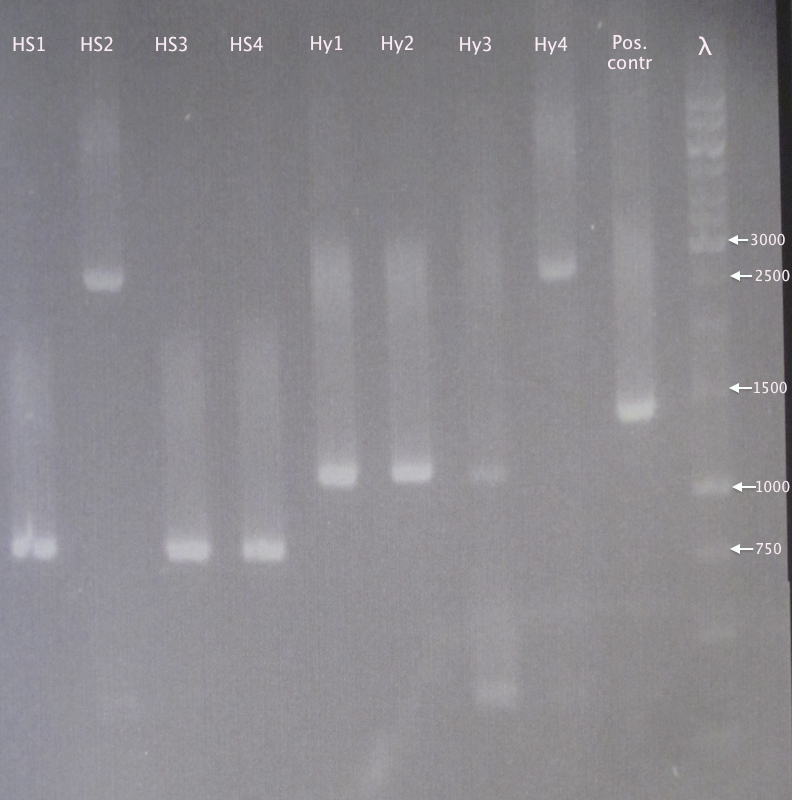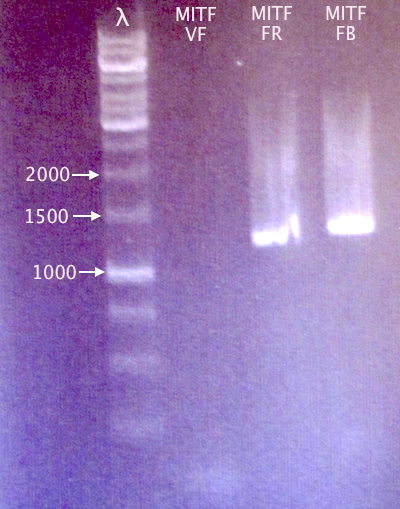Team:Stockholm/24 August 2010
From 2010.igem.org
(→Andreas) |
|||
| Line 291: | Line 291: | ||
*1.5 μl ligation mix. 20 min incubation on ice. | *1.5 μl ligation mix. 20 min incubation on ice. | ||
*Amp 100 LB agar plates | *Amp 100 LB agar plates | ||
| + | |||
| + | {{Stockholm/Footer}} | ||
Revision as of 11:00, 26 October 2010
Contents |
Nina
Tranformation of protein A
I transformed 100 ul BL21 cells with both 1 and 3 ul of protein A inserted into the peX vector. This transformation is carried out in order to perform an IPTG induction on protein A in BL21 e.coli cells.
The transformation procedure is described in protocols. However, in step 1 I thawed the cells in 15 min instead of 10 min. In step 2 I added 1 ul of DNA sample to 100 ul BL21 cells and 3 ul of DNA sample to an additional 100 ul BL21 cells.
Sequencing of tyrosinase
Since the last sequencing of the two tyrosinase samples did not turn out well, I send two new tyrosinase samples for sequencing. This time I mixed the sample with primers complementary to the bank vector iGEM send the gene in. I therefore mixed with the primer VR. I choose VR instead of VF2 because I wanted the primer to bind closer to the site where I performed a site directed mutagenesis.
I prepared two tubes of tyrosinase:
15 ul plasmid from a mini-prep and 1.5 ul (10uM) primer VR of the vectors verification primers.
- Colony #4: ASB0045 B01
- Colony #6: ASB0045 B02
PCR on N_CPP cluster
We obtained our N_CPP in a lysophilized form in an eppendorf tube, to which I added 24 ul of dH2O, vortexed and spann down by centrifuging ~10 seconds.
I prepared a PCR mix with the N_CPP cluster as the DNA template. This PCR product will in following days become digested and ligated into both the pEX and shipping vector.
PCR mix:
- Buffer Pfu buffer + MgSO4 10X 4.33 ul
- dNTP 10 uM 1 ul
- primer VF2 10 uM 3 ul
- primer pgex 10 uM 3 ul
- polymerase Pfu 1 ul
- DNA template 1 ul
- H2O 30 ul
I did a 1:5 dilution of primer pgex from 50 uM to 10 uM. 1 ul 50 uM primer and 4 ul dH2O.
PCR prgm:
Andreas
Glycerol stocks
From 23/8 ON cultures
1600 μl 100 % glycerol + 400 μl cell culture.
- pEX vector 24/8
- pSB1K3.SOD⋅His 1
- pSB1K3.SOD⋅His 2
New cultures of the pSB1K3.yCCS⋅His will be set, as the current ones did not grow.
Assembly of SOD/yCCS⋅His into pSB1K3
Transformation results
From 23/8 transformations
- pSB1K3.His⋅SOD: Good colony yield
- pSB1K3.His⋅yCCS: Good colony yield
Colony PCR
Picked four colonies from each plate for colony PCR, as follows:
- pSB1K3.His⋅SOD: HS1, HS2, HS3, HS4
- pSB1K3.His⋅yCCS: Hy1, Hy2, Hy3, Hy4
- Positive control: PC (pSB1K3.RFP plasmid)
Procedures according to colony PCR protocol.
- Elongation time: 1:40
Gel verification
1 % agarose, 100 V, 1 h
Expected bands
- pSB1K3.His⋅SOD: 815 bp
- pSB1K3.His⋅yCCS: 1100 bp
- Positive control: 1385 bp
Results
- His⋅SOD: Well corresponding bands for samples HS1, HS3 and HS4, with HS1 possibly being slightly larger than the other two. This could also be an artifact from the gel.
- His⋅yCCS: Well corresponding bands for samples Hy1 and Hy2.
ON cultures
Clones HS1, HS3, Hy1 and Hy2 were selected for verification by sequencing. ON cultures were set for plasmid and glycerol stock prep:
- Plasmid prep
- 5 ml LB + 50 Km
- 37 °C, 250 rpm
- Glycerol stocks
- 3 ml LB + 50 Km.
- 30 °C
MITF BioBrick construction
New MITF primers
| MITF primers |
|---|
>pRc/CMV_VF (24 bp) AATACGACTCACTATAGGGAGACC >pRc/CMV_VR (20 bp) CGTTACTAGTGGATCCGAGC >MITF_F_18aug (32 bp) CTGGAAATGCTAGAATATAATCACTATCAGGT >MITF_R_18aug (20 bp) ACAAGTGTGCTCCGTCTCTT >MITF_FB-F_18aug (64 bp) GAAGAATTCGCGGCCGCTTCTAGATGGCCGGC CTGGAAATGCTAGAATATAATCACTATCAGGT >MITF_FB-R_18aug (53 bp) GAACTGCAGCGGCCGCTACTAGTATTAACCGG TACAAGTGTGCTCCGTCTCTT |
New primers for MITF and pRc/CMV vector arrived.
- pRc/CMV verification primers
- pRc/CMV_VF
- pRc/CMV_VR
- MITF amplification primers
- MITF_F_18aug
- MITF_R_18aug
- MITF amplification primers with 5' prefix/suffix primer extensions
- MITF_FB-F_18aug
- MITF_FB-R_18aug
PCR amplification
Ran PCR reactions using the three primer pairs and pRc/CMV.MITF plasmid DNA:
- MITF VF (pRC/CMV verification primers)
- MITF FR (MITF amplification primers)
- MITF FB (MITF BioBrick primers)
PCR tubes (25 μl total volume)
- illustra Ready-to-Go PCR tubes
- Forward primer: 1 μl
- Reverse primer: 1 μl
- pRc/CMV MITF plasmid DNA (95 ng/μl): 0.5 μl
- dH2O: 22.5 μl
- pRC/CMV verification
PCR program
| MITF FB PCR program | ||
|---|---|---|
| 1) | 95 °C - 10:00 | |
| 2) | 95 °C - 00:30 | x5 |
| 3) | 55 °C - 00:30 | |
| 4) | 72 °C - 01:40 | |
| 5) | 95 °C - 00:30 | x25 |
| 6) | 72 °C - 00:30 | |
| 7) | 72 °C - 01:40 | |
| 8) | 72 °C - 10:00 | |
- MITF VF: Same as colony PCR settings above.
- MITF VR: Same as colony PCR settings above.
- MITF FB: See table to the right.
Gel verification
1 % agarose, 100 V, 45 min
Expected bands
- MITF VF: ?
- MITF FR: 1254 bp
- MITF FB: 1313 bp
Results
Bands for both MITF FR and MITF FB correspond to expected fragment sizes, indicating successful MITF amplification! No band for MITF VF, but if the MITF FB band is correct, the pRc/CMV verification primers are not needed.
Transfer of MITF to pSB1C3
Digestion
Digested pSB1C3 vector (w/ RFP insert) as well as amplified MITF DNA with EcoRI and PstI.
[pSB1C3.RFP] = 201 ng/μl
| Digestion tubes | ||
|---|---|---|
| [μl] | pSB1C3 | MITF |
| 10X FD buffer | 3 | 3 |
| DNA | 10 (2 μg) | 10 |
| dH2O | 15 | 10 |
| FD EcoRI | 1 | 1 |
| FD PstI | 1 | 1 |
Incubation: 37 °C, 10 min
Enzyme inactivation: 80 °C, 5 min
Ligation
| Ligation tube | |
|---|---|
| Vector DNA (pSB1C3) | 1.5 μl |
| PCR DNA (MITF) | 10 μl |
| dH2O | 3.5 μl |
| 5X Rapid Ligation buf. | 4 μl |
| T4 DNA Ligase | 1 μl |
| 20 μl | |
Incubation: 22 °C, 10 min
Quick transformation
Procedures according to protocol
- 1.5 μl ligation mix
- Cm 25 LB agar plates
Tranfer of RFP to pEX
Continued from 23/8
Transformation results
Very few and small red colonies, difficult to pick. Decided to make a new ligation with a higher insert:vector ratio.
Ligation
| Ligation tube | |
|---|---|
| Vector DNA (pEX, 33.3 ng/μl) | 1 μl |
| Insert DNA (RFP, 66.6 ng/μl) | 5 μl |
| dH2O | 9 μl |
| 5X Rapid Ligation buf. | 4 μl |
| T4 DNA Ligase | 1 μl |
| 20 μl | |
Digested pEX and pSB1C3.RFP samples from 23/8 and 19/8, respectively.
Incubation: 22 °C, 10 min
Quick transformation
Procedures according to protocol
- 1.5 μl ligation mix. 20 min incubation on ice.
- Amp 100 LB agar plates
 |

|
 |

|
 |

|

|

|
 "
"




